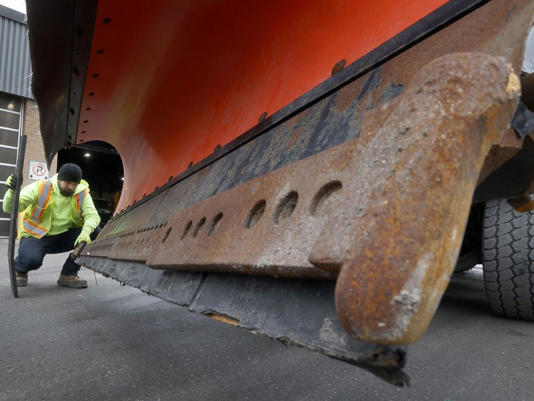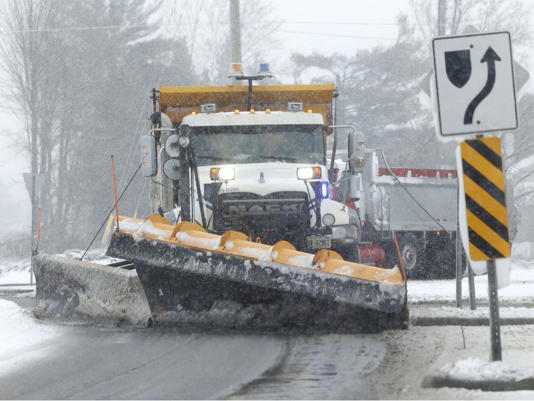Ottawa's road salt use is the highest in Canada. Here's what you need to know
At the risk of pouring more salt into the wound of our long and wicked winter weather , Ottawa is the Canadian road salt champion.
We use more rock salt compounds — an average of 156,000 metric tonnes for each of the past five winters — than any other municipality in the country.
We don’t foresee city council calling for an order of “We’re Number One” T-shirts or baseball caps, but there is plenty of spice that goes into those heavy salt trucks that keep us from slipping on our icy roads and sidewalks during snowy and icy conditions.
The science and environmental concerns have evolved and the city now uses both standard road salt — also known as halite — and calcium chloride for melting purposes.
Elsewhere in North America, cities are using salty beet, pickle, molasses and cheese compounds to melt ice.
We’ll get to more of that tasty conversation in a moment, but first, a little history.
When did we start shaking salt on the streets?
When the rubber started hitting the road and vehicle traffic soared in the 1930s and 1940s, road salt became the magic Band-Aid solution to help keep cars out of ditches during the worst winter weather.
The science for its success in keeping roads safe is simple enough. Saltwater, a combination of sodium and chloride, freezes at a lower temperature than standard water. Accordingly, when it’s applied to roads and sidewalks, the ice melts.
At $65 per metric tonne, salt also has the added benefit of being relatively cheap, compared to other melting compounds.
Calcium chloride is more effective because it melts at an even lower temperature, but it costs $140 per tonne.
For comparison’s sake, EcoTraction, a gritty sand-like mixture sold in stores and generally used to improve stability on sidewalks and driveways, retails at more than $1,600 per tonne.
Considering how much salt we use, every dollar counts.
During the mild winter of 2023-24, when only 133.7 centimetres of snow fell, the city used more than 120,000 metric tonnes of salt and there were 91 freeze-thaw cycles. In 2022-23, with 329.5 centimetres dropping and 75 freeze-thaw cycles, the salt load topped 204,000 metric tonnes.
Across Canada, five million tonnes of road salt is used each winter.
How much damage can that cause on and under the streets?
Plenty. Rust, as Neil Young once wrote, never sleeps.
Over time, excessive salt use has significant corrosive effects on roads, underground pipes and cars.
Car rust might be good for the automotive repair industry, but it’s bad for the lifecycle of vehicles in cold climates.
It also leads to asphalt breaking down in the freeze-thaw cycles, leading to the nightmarish potholes that test our patience and use of four-letter words.
Metal and concrete supports on bridges are also especially vulnerable to damage.
“Salt, in terms of sodium chloride, can penetrate into the concrete and the chloride ions can disrupt the protective layer that is naturally formed around the steel rebars in concrete structures,” said Jieying Zhang, principal research officer at the National Research Council of Canada’s construction division.
“This can cause corrosion of the steel. When that happens, the corrosion can disrupt the concrete’s integrity and crack it.”
Can road salt make its way into the ground and waterways?
Absolutely. The salt run-off from the roads, often called “salt splash,” can increase the level of chloride in the atmosphere.
The Ottawa Riverkeeper has just completed a five-year study, including 500 samples taken at 12 locations, about the impact of road salt on the city’s watershed. The findings were “devastating”, according to Larissa Holman, director of science at policy for Ottawa Riverkeeper. Due to increased chloride, the samples taken at dozens of locations — including Green’s Creek, Mother Award Ditch, Nepean Creek, Nesbitt Creek and Pinecrest Creek — were found to be either “acutely toxic” or “chronically toxic”. Higher chloride levels were even found in the summer when it enters the water following heavy rainfalls.
“Once it breaks down and does what it’s supposed to do, it moves to sewer systems and often into local creeks,” said Holman.
The health of the smallest organisms, which often live at the bottom of the water, is affected. “It has a huge impact on the ecosystem and there’s decreased biodiversity,” she said.
Higher levels of sodium in the water supply also pose problems for those with hypertension.
Have those concerns been heard?
Environmental agencies throughout North America have offered guidelines on reducing salt use. However, while the
the Canadian Environmental Protection Act of 1999 determined that certain salts — including those “containing inorganic chloride with or without ferrocyanide salts” were posing a risk to fish and water ecosystems — Holman says there’s limited punishment for those who use too much.
The biggest problems stem from salt use on the roads where traffic is densest.
Private contractors and homeowners, she says, also typically use far too much salt than is necessary. One coffee mug of road salt spread thinly is enough to melt the ice on a two-car driveway.
Holman says a pilot project in Gatineau, where only gravel and dirt are being used on the roads in five neighbourhoods, holds some promise.
The city of Ottawa does consult with the Ottawa Riverkeeper and follows provincial guidelines that include seeking out alternative solutions to cut back usage wherever possible, depending on existing conditions.
“The city uses a variety of materials at different application rates that match the weather,” said Christopher Paquette, program manager for operational research and projects. “We tailor our application rates to the specific conditions, adjusting for snow and ice accumulation rates and temperature ranges. A large portion of the rates are a mixture of rock salt and liquid calcium chloride.”

Ottawa city plows have been outfitted with the new rubber blades that are replacing steel blades on most of the city’s snow plows. Amos McWilliams, a heavy equipment operator for the city of Ottawa, inspects the rubber which is mounted on the former steel plow blade in this file photo.© Tony Caldwell
What else is the city doing?
Beginning last winter, the city introduced something called Ground Speed Oriented Electronic Controllers on three sidewalk spreading units. The goal is aimed at improving efficiency and addressing environmental concerns. The system helps “monitor and adjust salt applications in real-time based on vehicle speed and surface conditions,” according to Paquette.
The benefit is that salt is distributed “ensuring precise calibration and optional use.”
This winter, the controllers are being used in a dozen sidewalk spreading units.
The city is also using new carbide-encapsulated rubber blade segments on its heavy snowplows, which should also reduce the amount of salt necessary.
“It has shown great promise to scrape the roads better, which results in a reduction in salt application,” said Paquette.
Why do trucks pre-coat the roads before major weather events?
The calm before the storm is vital in getting ahead of the nastiness.
Pre-salting roads establishes a layer of “brine” on the pavement, which decreases how much ice can form. In Ottawa, liquid calcium chloride is often mixed with standard road salt. The additional advantage of applying a liquid layer is that road salt is less likely to splash away.

Ottawa city snow plow during a snow storm in a file photo.© Tony Caldwell
Does road salt run-off have an impact on building ice for the Rideau Canal?
It can, if only to a small degree.
While the Rideau Canal Skateway is operated by the National Capital Commission, the city of Ottawa is responsible for salting Colonel By Drive and the Queen Elizabeth Driveway.
“Road salt is introduced not only from nearby driveways but also from the numerous overhead bridges that cross the Skateway,” said NCC strategic communications advisor Benoit Desjardins. “Additionally, storm drains also contribute salt to the canal, all of which create challenges for ice formation.”
And those wooden planks along the Queensway bridge atop the Canal? They were installed by the Ontario government to reduce how much snow and salt drop onto the ice surface.
So, what about those vegetable and cheese cocktails?
Toronto, Halifax and Laval are among the Canadian cities that have experimented by spraying a salty beet brine on roads before major storms. The benefits include cost efficiency, and the fact it’s easier on the environment and can melt ice at lower temperatures. The beet concoction also freezes at a lower temperature than standard road salt, which begins losing effectiveness at minus 7 degrees Celsius. It is possible to create homemade solutions for driveway use but beware, purple beets can leave a mark. Anyone who has digested beets is familiar with the colouring that occurs.
In the U.S., transportation agencies are increasingly using what’s available to them to find more environmentally friendly road brines. That includes pickle juice on some roads in Pennsylvania, which is home to the Heinz pickle factory.
A salty cheese mixture is also being used in — where else? — Wisconsin, where three billion pounds of cheese is produced each year. Rather than have companies pay to dispose of waste, the state collects it and then re-uses that leftover brine. Just like the beet and pickle mixtures, the cheese cocktail is mixed with road salt. It, too, freezes at a lower temperature, reducing icy conditions.
It certainly provides food for thought in keeping at least some of the ice away.
